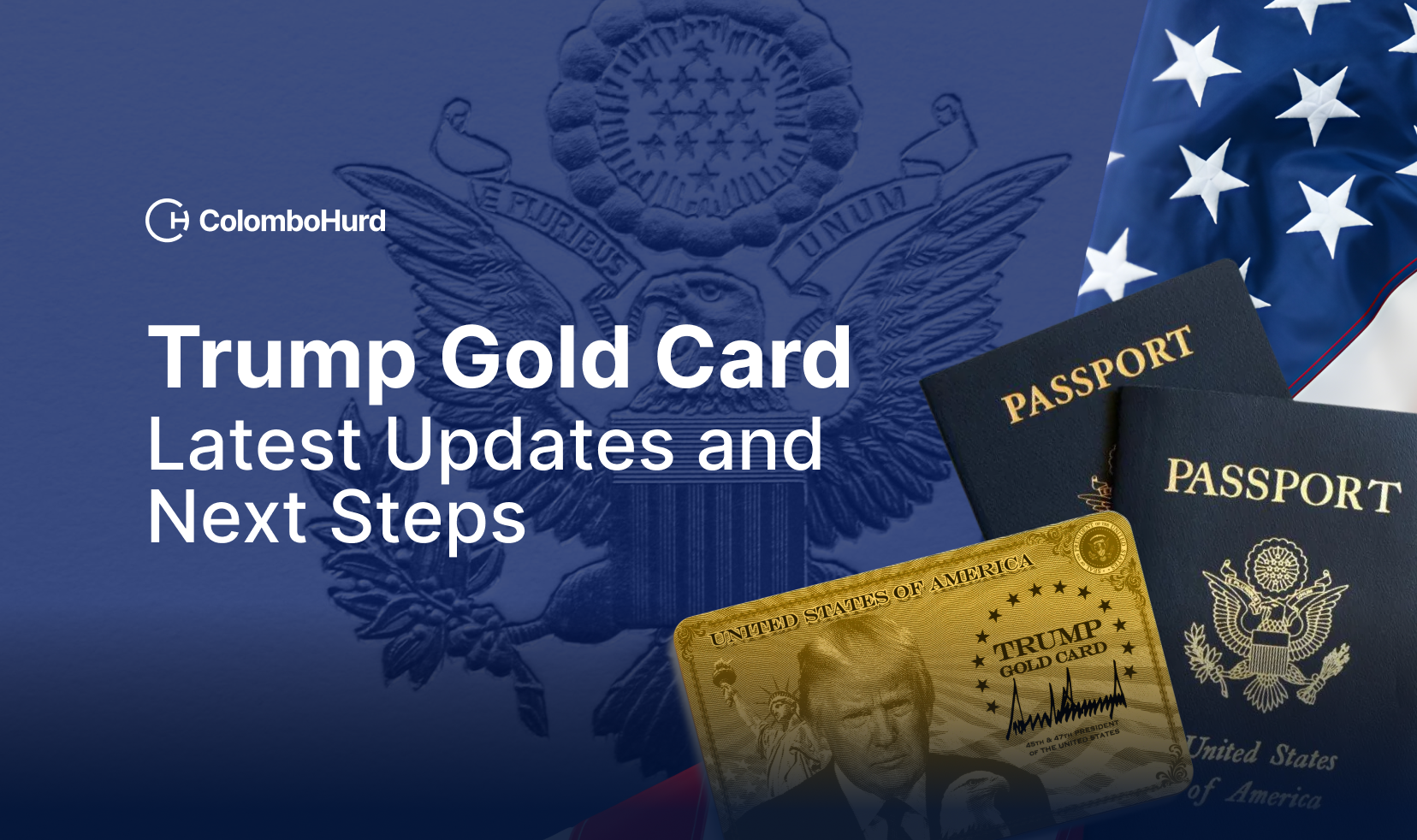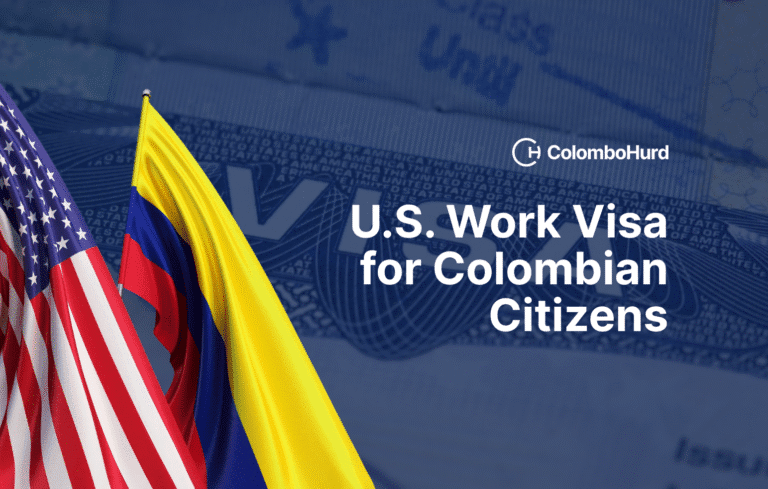
On This Page
- A Brief Timeline of The Gold Card Visa
- Cost Structure: $1 Million Per Family Member
- How the Gold Card Process Would Work
- The Category Question: EB-1 vs. EB-2?
- Comparing With Existing Alternatives
- Unexpected Documentation Requirements
- Pending Questions About the Gold Card Visa
- Next Steps and Timeline
- Our Perspective at Colombo & Hurd
- Conclusion
The Gold Card immigration initiative, first announced earlier this year and then in an Executive Order in September, has taken another significant step forward. On November 19th, the draft Form I-140G, Immigrant Petition for the Gold Card Program, was submitted to the Office of Management and Budget (OMB) for federal review. This is a required step toward meeting the December 18th deadline established by President Trump.
However, the Gold Card visa is not open for applications yet. Many key details about how the final program will work are still undecided.
A Brief Timeline of the Gold Card Visa
The Gold Card immigration initiative has been publicly discussed since January 2025, when it was first mentioned with an initial estimate of $5 million. On September 19, 2025, President Trump issued an executive order that reduced the amount to $1 million for individual applicants or $2 million for corporate sponsorship.
The order established a 90-day deadline for full implementation and specified that applicants would receive lawful permanent resident status under the EB-1 or EB-2 visa classification. It also directed that all donations would be deposited with the Department of Commerce to “promote American commerce and industry.”
Now, in November 2025, we have a concrete form under review, the I-140G, which gives us a much clearer picture of how Trump’s Gold Card could function in practice.
Cost Structure: $1 Million Per Family Member
The draft Form I-140G clarifies a point that generated considerable discussion among immigration professionals: the $1 million requirement applies individually to each person included in the petition, not to the family as a whole.
This means that the $1 million donation applies to the principal applicant, the spouse, and each child included in the petition. For a family of four, this would result in $4 million in donations to the United States government, plus $60,000 in non-refundable filing fees ($15,000 per person).
This structure differs significantly from other immigration pathways. In traditional programs like EB-5, EB-1, and EB-2 NIW, only the principal applicant needs to meet the financial or qualification requirements. Spouses and children are included as “derivatives” without additional investments or separate substantive requirements.
How the Gold Card Process Would Work
According to the draft form instructions, the Gold Card process would be structured in three main stages. The first stage would involve submitting an application. The second stage would be payment of a non-refundable fee of $15,000 per person through the federal government’s pay.gov portal. Finally, in the third stage, the applicant would submit Form I-140G to USCIS.
Form I-140G requires the applicant to choose between the EB-1A category (individuals of extraordinary ability) or EB-2 National Interest Waiver (NIW). The required documentation is extensive. The applicant and each family member must provide complete employment history for the past 20 years and complete educational history from post-secondary education to the present. The form instructions are vague regarding how these requirements would apply to minor children who would not have employment history. The form also requires a complete list of all financial accounts belonging to the applicant and spouse, including cryptocurrency accounts.
Documentation of the source of funds must be presented in detailed worksheet format. For cryptocurrency funds, there are specific requirements: funds must be traceable through blockchain with wallet identification through regulated financial institutions. USCIS may request additional evidence regarding the origin and path of funds to the Department of Commerce.
The form includes several self-attestation statements related to national security, fraud, money laundering, terrorism, and the lawful origin of Gold Card funds. For corporate petitions, the sponsoring company must provide three years of federal tax returns, annual reports, or audited financial statements.
Once the I-140G petition is approved and an immigrant visa number is available in the requested classification, the applicant must complete consular processing at an embassy or consulate to obtain an immigrant visa and travel to the United States to be admitted as a lawful permanent resident. The draft instructions do not specifically address adjustment of status for Gold Card petition beneficiaries already in the United States, although this option is expected to be available.
The Category Question: EB-1 vs. EB-2?
An interesting aspect of the form is that it allows the applicant to simply choose between the EB-1A or EB-2 NIW category, without needing to demonstrate meeting the traditional criteria of either category. The donation itself serves as evidence of eligibility.
It’s important to note that, despite language in the executive order and on the Gold Card website suggesting expedited processing, there is no indication that Gold Card applicants will receive exemption from existing visa quotas or have a separate priority line. They will compete for the same green card slots as traditional EB-1 and EB-2 applicants. Visa availability remains subject to the limits established by Congress in existing immigration laws. There is no quota separation and no priority queue.
Comparing With Existing Alternatives
For professionals and investors considering pathways to permanent residence in the United States, it’s worth examining the options that are already available and functioning today.
The EB-5 Immigrant Investor Program allows foreign investors to obtain permanent residence by making an investment in a U.S. business that creates jobs. EB-5 costs between $800,000 and $1.05 million for the entire family. Importantly, this is an investment with the possibility of capital return. Most large EB-5 projects have a built-in plan to repay the investment or provide a return on investment. The program is available now, and this is one of the best periods for EB-5 in terms of green card availability, with nearly all categories and countries being current.
The proposed Gold Card would cost $1 million per person, plus $15,000 in fees per person. Unlike EB-5, this would be a donation to the government with no possibility of return. The requirement would be the donation, plus extensive documentation of the source of funds. The initiative is not yet open for applications.
For an in-depth comparison of the existing EB-5 Investor Program and the Gold Card, see Colombo & Hurd’s Trump Gold Card vs. EB-5 article.
The EB-2 NIW allows qualified professionals to obtain permanent residence without employer sponsorship by demonstrating that their work substantially benefits the United States. Standard government fees total approximately $3,000 to $5,000. The requirement is to demonstrate substantial national benefit through work or expertise in the professional’s field.
Unexpected Documentation Requirements
One aspect that caught our attention when reviewing Form I-140G is the extent of biographical and employment documentation required, even though the initiative is based on financial donation rather than professional qualifications. The form requires complete employment history for 20 years, complete educational history, and information about any positions held in the government or military at any point in the applicant’s life.
This is interesting, as each applicant will already need to provide this detailed information in consular processing through Form DS-260 or in an adjustment of status application through Form I-485. These are the standard forms for obtaining a green card that every immigrant must complete. The duplication of these extensive requirements is not typical in immigration processes and adds an additional layer of complexity to the Gold Card process.
This extent of requirements clearly suggests that the process may not simply be “pay and receive.” There could be substantial review of both finances and the applicant’s complete background, despite the initiative being based on donation rather than professional merit.
Pending Questions About the Gold Card Visa
Although the draft form provides much more clarity on the Gold Card initiative than before, several important questions remain unresolved.
The per-person cost structure has not yet been officially finalized. The current form is a draft undergoing federal review, and adjustments may occur before launch. Operational details about how donated funds will be used remain vague. The executive order specifies that they will be used to “promote American commerce and industry,” but does not detail specific programs or initiatives.
Adjustment of status, which allows someone already in the United States to apply for a green card without leaving the country, was not explicitly addressed in the draft form instructions. Although this option is generally standard for those legally in the United States, official confirmation is still expected.
The Gold Card government website also references a “Platinum Card” that would allow a foreign national who contributes $5 million to reside in the United States for up to 270 days per year without U.S. tax exposure on non-U.S. income. However, to date, there is no executive order, form, or formal details about this initiative.
Next Steps and Timeline
Form I-140G is currently under review by the Office of Management and Budget, a mandatory step in the federal regulatory process. The deadline established in the presidential executive order is December 18, 2025 for complete implementation. In the coming weeks, additional guidance is expected from USCIS and the Department of Commerce as they work to meet this deadline.
It’s essential to be clear: the initiative is not accepting applications at this time. There is no way to apply until the form is finalized, the review process is completed, and the initiative is officially launched. Any website or service claiming to be accepting Gold Card applications now would be fraudulent.
Our Perspective at Colombo & Hurd
At Colombo & Hurd, we are closely monitoring the development of the Gold Card initiative. As a firm specializing in merit-based immigration and investor visas, we are prepared to evaluate this initiative when and if it becomes an operational reality.
The draft Form I-140G represents the first concrete document about how this initiative would function. We will continue monitoring developments until the December deadline and will provide updates as more information is released by USCIS and the Department of Commerce.
Meanwhile, it’s important to remember that established pathways like EB-5, EB-1A, and EB-2 NIW are available and functioning today. If the Gold Card concept sparked your interest in establishing permanent residence in the United States, we can help you explore viable options now.
For Investors: The EB-5 program is currently in an excellent moment in terms of green card availability. This pathway offers an established process with the real possibility of investment return. Explore EB-5 investment opportunities here to learn more about how this program could work for you and your family.
For Professionals with Extraordinary Ability: Evaluate your EB-1A profile here to see if you qualify for this pathway designed for professionals with extraordinary achievements in their fields.
For Professionals Benefiting the U.S.: Check your EB-2 NIW eligibility here if your work substantially benefits the United States.
Conclusion
The draft Form I-140G represents an important milestone in the development of the Gold Card initiative. With the December 18th deadline approaching rapidly, we expect more clarity and detailed guidance in the coming weeks.
Colombo & Hurd will continue closely monitoring developments and is ready to help clients navigate any new option that emerges. At the same time, we continue providing specialized guidance on the established pathways available today, helping professionals and investors from around the world achieve their U.S. immigration goals.
Related Resources
Trump Gold Card EB5 Investment Options Comparison
See if you qualify for the EB-2 NIW





